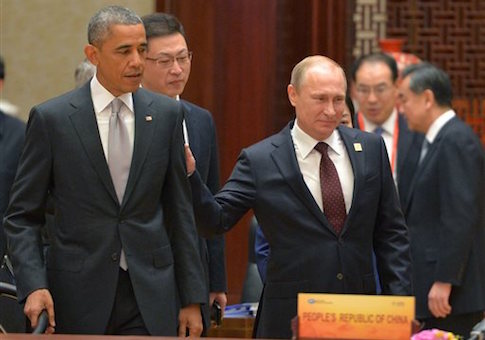A professor at Georgetown and former Russian government hand, Angela Stent has spent her career examining or participating in U.S.-Russia relations. In The Limits of Partnership she explains why America’s post-Cold War relationship with Russia has been so troubled.
Stent begins by examining the divergent analyses with which Russia and the United States understood the end of the Cold War. Discussing the over-optimistic hope that Russia would transition from Communist authoritarianism to democracy, Stent makes use of political history. "The tsarist patrimonial state, where the aristocracy was dependent on the ruler’s goodwill to maintain its status and property, was replaced by a Soviet patrimonial state, where the Communist party was in charge of patronage. In neither system were property rights or the rule of law much respected—or even recognized." Stent notes that this ideology of authoritarianism is inherent in Vladimir Putin’s self-conception and policies. Indeed, she continues, many Russians support this conception of their state, inasmuch as the democratic experience of the 1990s is widely remembered as a period of "disorder and unpredictability and humiliation by the west."
Beginning with the Clinton-Yeltsin relationship, Stent explains that American officials neglected Yeltsin’s great anxiousness over perceptions of weakness. This misreading, she argues, has persisted as Russian and American leaders have struggled to forge consensus. Russians continue to expect deference even after the end of the Cold War. When—whether under Yeltsin, Medvedev, or Putin—they’ve regarded American respect as absent, Russia’s leaders have reacted angrily.
For Stent, the dimension of human emotion has been incredibly important to U.S.-Russian disagreements since 1991. For example, while the Bush administration believed its ‘freedom agenda’ was strengthening democracy without damaging Russian national security, Russia saw the agenda as an American attempt to seize geopolitical influence from Russia—in other words, as a thinly veiled mechanism of realpolitik.
As Stent’s book advances, however, the reader is left with little doubt that a key cause of difficulty in the relationship has been President Putin’s miscalculation of his own importance as a U.S. partner. Wherever he has made concessions, for example—whether NATO access to Afghanistan, or trading opportunities, or missile agreements—Mr. Putin has believed the U.S. president should make far greater concessions in return. Most notably, the Russian leader believes the United States should allow Eastern Europe to remain under Russia’s umbrella of direct influence. When these concessions haven’t been forthcoming, President Putin has taken their absence as an American insult.
What is also striking about Stent’s accounting—the most comprehensive thus far produced—is the arrogance with which the Obama administration believed it could simply make Putin its partner. As Stent explains, the now infamous "reset" button was part of a broader delusion on the part of the U.S. government that major concessions would earn reciprocity.
Stent explains how this delusion was matched by a simultaneous betrayal of U.S. allies. By first staying silent on NATO enlargement, then by abandoning President Bush’s missile defense policy in the summer of 2009 (only informing leaders in the Czech Republic and Poland just before his announcement), Obama signaled an opportunity to President Putin. Though Stent doesn’t say so, the reader is left with the distinct impression that these acts helped encourage Russia’s present aggression in Ukraine.
Stent is keen to point out that the greatest difficulty in the post-Cold War relationship has been the often fundamentally divergent policy objectives of each nation. On Syria, Stent explains that Russia’s policy is focused on economic opportunity rather than humanitarian concerns, and that President Putin finds "leverage" in unresolved international disputes like this one. He has little interest in aligning with key U.S. interests.
Refreshingly, Stent is willing to point out that Russia’s oft-stated sympathy for United Nations authority is actually a cynically employed means to resist American power with the pliable bureaucracy of international law. Stent also mentions what’s sure to be a growing influence on Russian foreign policy: Its deep concern that the U.S. shale energy revolution will degrade Russia’s own energy export market and the crucial source of revenue this provides.
Perhaps surprisingly, Stent’s conclusion is not entirely downcast. In areas of economic reform and trade, she suggests that there are untapped opportunities. Her concluding thesis is simple in its optimism—and perhaps just a little simple: Rather than focusing on grand objectives and historic partnerships, American leaders should center their relationships with Russia on pragmatic small-scale areas of potential compromise.
